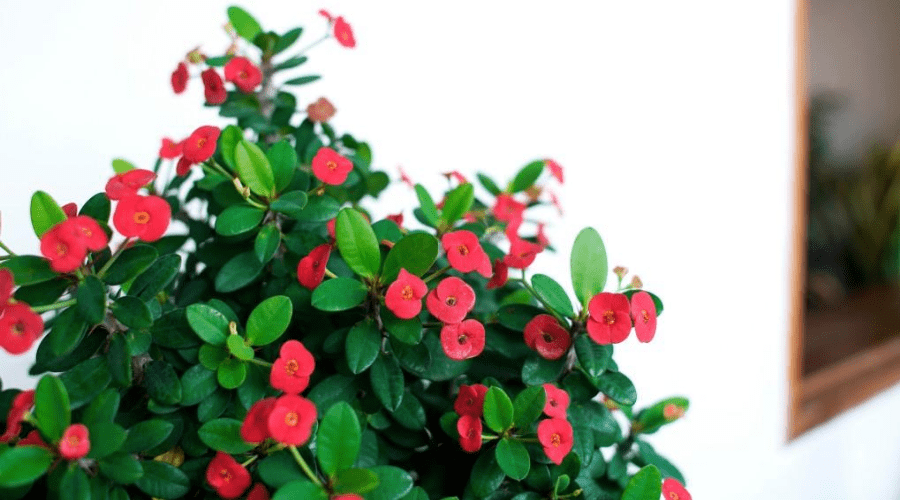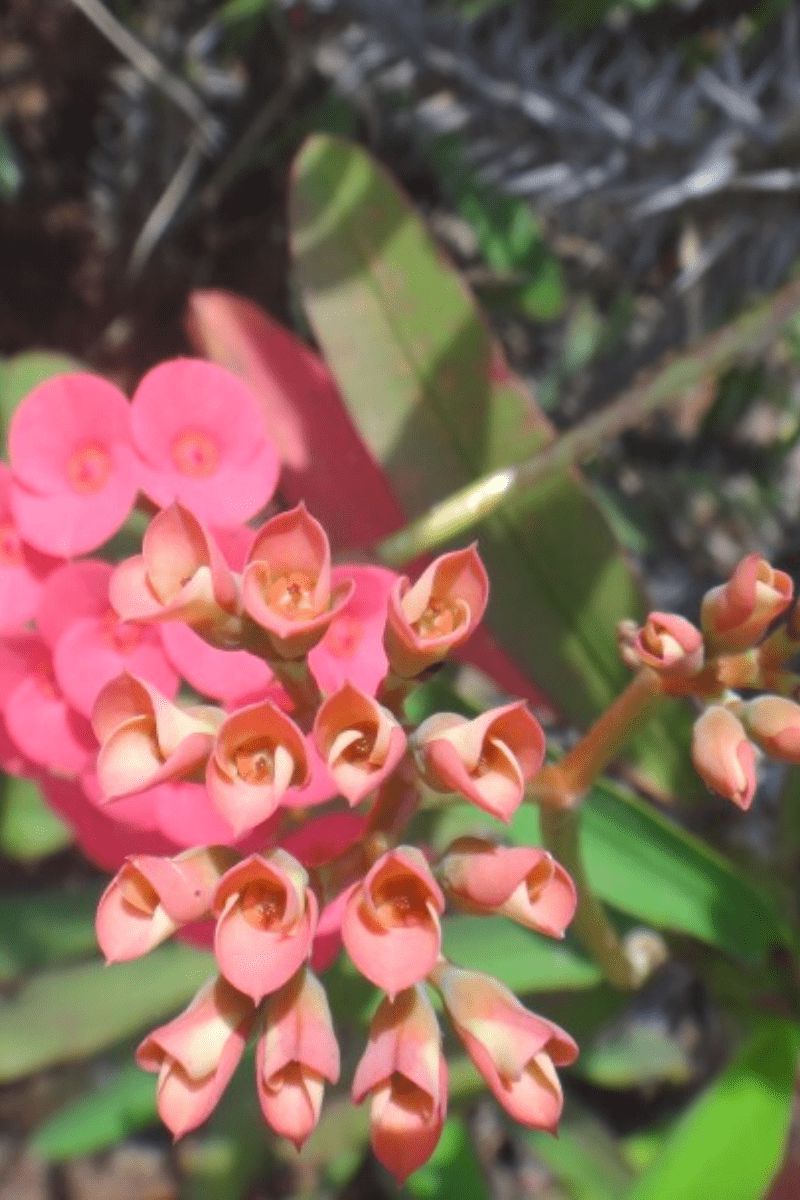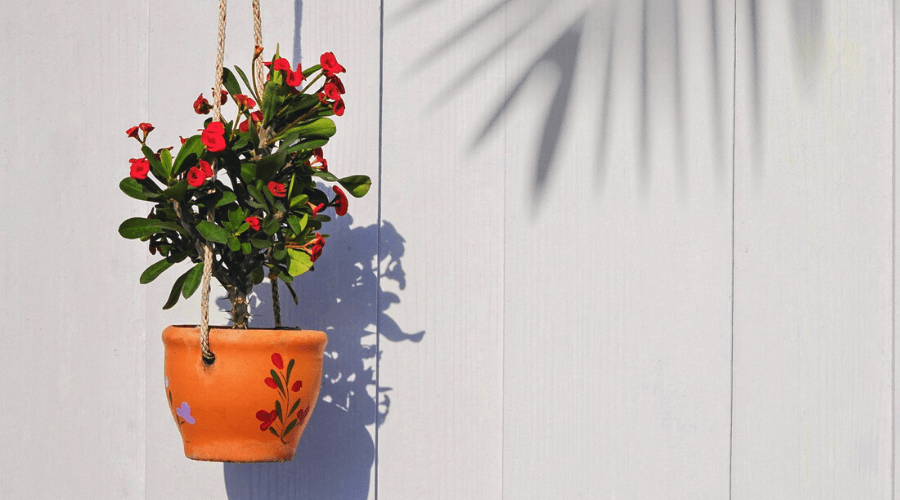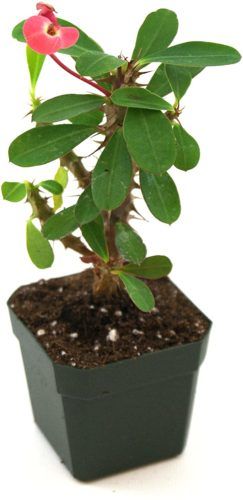With a name like crown of thorns, you know this is a dramatic plant. And the drama is definitely delivered on with this plant’s unique succulent base, rows of thorns, and brightly colored, vibrant flowers. However, its care is rather drama-free as long as you keep a few key tips in mind. This comprehensive guide covers everything you need to know about how to grow the crown of thorns plants so they produce the brilliant blooms that make them such a popular house and garden plant.
Crown of Thorns Details
Euphorbia milii
AKA Crown of Thorns, Corona de Cristo, Christ Plant, Christ Thorn
Light: Direct sunlight
Water: Infrequent, deep waterings
Temperature: 65 - 75 F
Size: <6 feet tall
Pests: Scale, mealybugs, thrips
Diseases: Root rot, fungal diseases
Toxicity: Toxic to humans and pets
What Is the Crown of Thorns?
Crown of thorns are evergreen succulents that are famous for their gorgeous blooms. Unbeknownst to most people, the flowers on crown of thorns plants are actually just the small center of their “blooms.” The colorful “petals” are large bracts surrounding the tiny flowers. The bracts come in vibrant shades of red, pink, and orange.
This easy-to-grow succulent originated in Madagascar. Because of this, it appreciates warm weather and can only be grown in USDA Plant Hardiness Zones 9 - 11. However, it makes an excellent house plant and can be grown year-round all over the world.
The name Crown of Thorns did not come from an especially poetic botanist. It actually is derived from a legend that says the plant was used to make the thorny crown that was put on Jesus when he was crucified. Because of this, it also goes by the names Christ plant and Christ thorn.
Crown of Thorns Care
First, a Warning
Your crown of thorns may not need much protection, but you do. Not only can the plant’s massive spines hurt you, but its toxic sap is no joke. The milky sap can sting and irritate skin and eyes. Never ingest it, and never let kids or pets eat it or any other part of the plant. Always wear gloves when handling your crown of thorns, and move it by grabbing its leafy stems or roots.
Light
Place your crown of thorns somewhere where it will receive at least 6 hours of direct sunlight each day. Try a south or west-facing window for maximum sunlight keeping in mind that less sunlight will result in fewer flowers.
Water
Crown of thorns are drought-tolerant plants, so don’t sweat about forgetting to water them. Since they are succulents, they can store water within their flesh. Because of this, crown of thorns plants prefer infrequent and deep waterings.
When the soil looks dry, stick your finger in about 2 inches deep. If it feels dry up to that point, water your crown of thorns plant.
Water thoroughly and make sure that the excess water is draining off. The soil should be moist but there should never be standing water on it.
In the winter water your crown of thorns less frequently, allowing the soil to more fully dry out.
Soil & Container
Fill a container with a well-drained potting mix. The container should be 1-2 inches bigger than the plant’s root ball. This is so that there isn’t any excess soil retaining water.
Loosen your plant’s root ball. Dig a hole in the middle of the potting mix and add the plant, gently patting soil back on top of its roots.
Pro Tip: A succulent or cactus soil mix work really well for crown of thorns plants.
Temperature & Humidity
Crown of thorns thrive in temperatures around 65 - 75 F which is, luckily, where most home’s thermostats sit. Of course, there is some wiggle room with that, the temperature can be a bit higher and can even reach as low as 50 F for short periods of time.
Your crown of thorns isn’t picky about humidity levels and can thrive in dryer conditions so don’t worry about misting it.
Fertilizer
Apply quarter strength balanced fertilizer to your crown of thorns on a monthly basis in the spring and summer. Make sure that the fertilizer is boron-free because crown of thorns plants can have a negative reaction to boron.
Pro Tip: If you are using a granular fertilizer you only need to feed your crown of thorns once every 3 months.
Growth Rate
On average crown of thorns plants grow to be between 2 - 6 feet tall and 3 - 5 feet wide. Of course, how big your crown of thorns grows depends on some factors.
Plants that are grown outdoors will grow to be taller because they have more room to grow and more access to nutrients. The same is true for if you frequently repot your crown of thorns.
Crown of thorns that are pruned back regularly will be shorter. However, regular plant maintenance and care are required for it to be healthy enough to grow.
Keep in mind though, if your plant is directing its energy towards growing height-wise, it may produce fewer blooms. So you have to ask yourself: Do you want a taller plant or a plant with more flowers?
Pruning
Crown of thorns is a slow grower so it does not need to be pruned for shape often. If you received a new plant, hold off on pruning for at least a couple of years.
When you do prune make sure it’s in dry, cool conditions to lessen the likelihood of diseases spreading. You should prune in early spring before new growth starts.
On a yearly basis you should remove leafless or crowded stems at the end of the growing season. It’s a good idea to thin out branches near the plant’s base to enable air circulation. Also, remove any dead or diseased parts of your plant to promote healthy growth.
Remember, always use a sharp, clean pair of pruners or scissors for cutting your plants.
Pro Tip: Make sure you are very careful to not only avoid thorns but also the plant’s sap while pruning.
Blooming
Crown of Thorns tend to bloom year-round when kept in a warm climate, but when exposed to the cold, may stop until the weather warms up again. This plant’s less-pretty adornment, spines, tend to grow to about 1-inch in length and protect it all year long.
Propagating Crown of Thorns
This resilient and low maintenance plant is, of course, easy to propagate. You should have no trouble turning this one plant into many.
Before the growing season begins, take some stems from your plant using clean, sharp scissors or pruners.
Dip the severed end of the cuttings into warm water, leaving them for five minutes until the milky sap stops running from them.
Then, place the cut pieces on paper towels allowing them to dry for a few days until the cut end callouses over.
Fill a container with sand and add moisture to it and then place the cut end, which is now the calloused end, into the sand and put it in a location with indirect light for 4 weeks.
At the end of the 4 weeks, tug on the pieces, testing for resistance. If you feel resistance they are ready to be repotted in potting mix in a permanent container. If you don’t feel resistance, leave them in the sand for a couple more weeks.
Crown of Thorns Varieties
There are numerous crown of thorns varieties, each of which are typically differentiated by the plant’s size and its bloom’s colors.
A popular one is “Brush Fire” which has thick leaves and vibrantly red flowers.
“Thai Giants” is a larger cultivar with bigger leaves and thorns, and bright pink blooms
Thai Crown of Thorns Pink Giant
Thai Giant Euphorbia milii was bred to produce large blooms, but also has larger thorns. This one ships at 8-inches in height.
“Short and Sweet” also has red flowers but was bred to be a dwarf variety so it does not surpass 12 - 18 inches in height.
Dwarf Apache is a smaller variety cultivated for indoor growth. Its flowers are hot pink and it grows to be only two feet tall or so.
Euphorbia milii 'Dwarf Apache'
Euphorbia milii ‘Dwarf Apache’ is a smaller version of the popular Madagascar native commonly called Crown of Thorns. Although they are technically a type of succulent, they require growing conditions more like tropical foliage than the typical succulents or cacti. This one ships in a 2.5-inch grower's pot.
Where to Buy Crown of Thorns
You can buy crown of thorns plants from your local nursery or online.
An excellent online option is this Red Crown of Thorns Plant. It’s shipped carefully in a five-inch pot. It may take some time to fully blossom but that has more to do with the transplant shock than the quality of the plant. With patience, and some effort put into caring for the plant, you will be rewarded with ravishing red blossoms in no time.
Red Crown of Thorns Plant
A famous houseplant, known for its ease of growth and flowering, the Crown of Thorns has graced windowsills for over a century with bursts of color while tolerating blind neglect. This dwarf form has flowers that populate the spiny stems.
Common Crown of Thorns Problems
There are no notable problems that you may encounter when taking care of your crown of thorns plants. Pests don’t tend to bug them, but if they do you can use a cloth and water to wipe them off.
The thing you should be most wary of is overwatering your plant and causing root rot. To avoid this always err on the side of underwatering. These are succulents, they were built to survive with less water.
Conclusion
Crown of thorns makes an excellent indoor plant, and if you live in the right zones, a beautiful addition to your garden. Balancing beautiful blooms, threatening thorns, a sturdy succulent base, and stinging sap, this plant is absolutely unlike any other.
I hope you found this guide helpful! If you did, be sure to share it and comment below with any questions you have!







